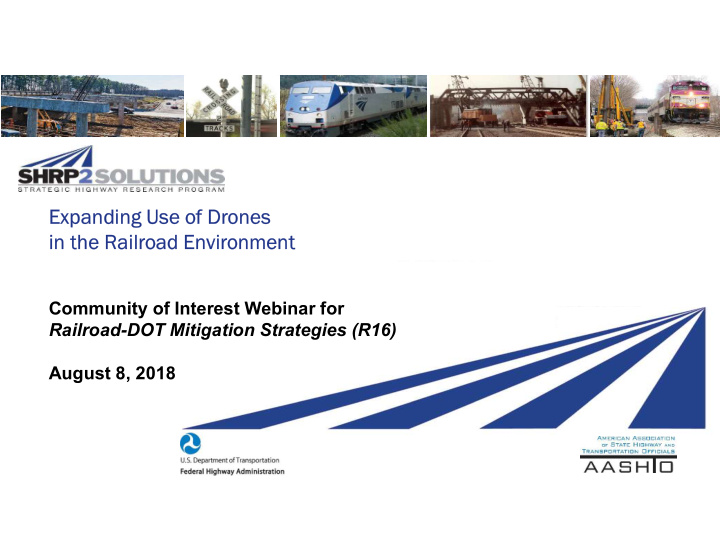



Expanding Use of Drones in the Railroad Environment Community of Interest Webinar for Railroad-DOT Mitigation Strategies (R16) August 8, 2018
Purpose of Today’s Webinar • Learn more about the SHRP2 R16 Railroad-DOT Mitigations Strategies Community of Interest and its Innovation Library. • Hear presentations from Utah DOT and BNSF regarding the increasing uses and value of Unmanned Aircraft Systems (Drones) to promote safety and efficiency in the Railroad Environment. • Discuss and ask questions in a robust exchange with presenters and participants. 2
Agenda • Welcome • Presentations: Unmanned Aerial Systems, Utah DOT BNSF Railway UAS Program, BNSF • Discussion and Comments
A Few Housekeeping Details • Tell us what you think . We want to hear from all of you on the call during the discussion segment. • Please add your comments to the chat box provided. 4
Welcome Presenters • Paul Wheeler, Lead UAS Coordinator, Utah DOT • Todd Graetz, Director of Technology Services, BNSF Moderators/Participants • Kate Kurgan, Moderator/ R16 Product Lead, AASHTO • Pam Hutton, SHRP2 Implementation Manager, AASHTO • David Solow, R16 Subject Matter Expert Transcript of the presentation will be posted on the AASHTO SHRP2 website: http://shrp2.transportation.org/Pages/R16_RailroadDOTMitigationStrategies.aspx 5
Focus Areas Safety : fostering safer driving through analysis of driver, roadway, and vehicle factors in crashes, near crashes, and ordinary driving Reliability : reducing congestion and creating more predictable travel times through better operations Capacity : planning and designing a highway system that offers minimum disruption and meets the environmental and economic needs of the community Renewal : rapid maintenance and repair of the deteriorating infrastructure using already-available resources, innovations, and technologies 6
SHRP2 Implementation: INNOVATE. IMPLEMENT. IMPROVE
SHRP2 Implementation: INNOVATE. IMPLEMENT. IMPROVE
What is SHRP2 R16? • Active Strategic Community of Interest (COI) • Strategies to Improve Railroad-DOT Cooperation and Accelerate Project Delivery • Innovation Library http://shrp2.transportation.org/Pages/R16_InnovationLibrary_Topi c.aspx • AASHTO Web Page Resources: http://shrp2.transportation.org/Pages/R16_RailroadDOTMitigation Strategies.aspx 9
Unmanned Aerial Systems (UAS) Program
Implementation Stages 2010 Testing in coordination with Utah State University • Southern Parkway Construction Monitoring • Wetland Plant Species Classification https://www.udot.utah.gov/main/uconowner.gf?n=10710706202834543
Implementation Stages • January 2016 Started Section 333 Process • Purchased 3 Aircraft June 2016 • Policy and Procedures Approved March 2017 • 2018 - 9 Remote Pilots
UAS Platform Utilization • Delamination (Thermal) • Mapping • Inspection • Increase Frequency • Improved Documentation • Supplement
Site Monitoring • Live Streaming Capabilities • Monitor Area • Bird’s Eye View at Low Cost • Route Management • Quick Response vs. Traditional Aircraft
UAS Platform Utilization • Highly Detailed Mapping Model • Safety • Speed of Collection • High Resolution Aerial Imagery with Point Cloud
Quality Control/Quality Assurance • Required on all Pre-Construction Surveys • Softscape Surfaces • Hardscape Surfaces • Hybrid Model
UAS Platform Utilization • First Project for 3D Model as Legal Document • Attribute based Model • Phasing/Changes Over Time • Used by Construction & Inspection • Compared against original design • Hybrid Data • GPS, UAS, LiDAR, Design • As-Built Model
UAS Platform Utilization • Overall savings for this project was $82,672 (2.58%) • Workforce was 45% more productive • Completed 25 days ahead of schedule
UAS Platform Utilization • Google Earth High Resolution Imagery • Wetland Mitigation – Jordan River • Galena Canal – Hot Spring • Monitor Noxious Weed Removal
UAS Platform Utilization • UAS for IMT Vehicles • Accident Reconstruction • Monitoring Alternative Routes • Real Time Broadcasting • Detour management • Search and Rescue
UAS Platform Utilization • Pavement Condition • Automated Crack Detection • Obstacle Clearance
Landslides Moki Dugway
Landslides Moki Dugway
UAS Platform Utilization • Detailed Aerial Imagery • Automated Detection
Data & Storage • Plan for large data sets • Keep all flight logs, files, and processed data. • GIS database for all Ortho Imagery. • https://uplan.maps.arcgis.com/home/webmap/viewer. html?webmap=dc81b7cbd5ce4f8fba086e05d723ffff
Lessons Learned • Understand radio link characteristics in multiple environments • Battery life and endurance • Plan for the worst, hope for the best • Looks can be deceiving • Initial test flight to scout for obstacles and heights prior to autonomous flight mapping. • Use aviation radio to monitor traffic • Establish good relationships with other entities and public. • Use visual observers for operations • Sterile environment for Pilot
Contact Info: Paul Wheeler Lead UAS Coordinator E-mail: pwheeler@utah.gov Phone: 801-965-4700
Questions? 28
For More Information Product Leads: Additional Resources: Jessica Rich GoSHRP2 fhwa.dot.gov/GoSHRP2 FHWA Product Lead Website: jessica.rich@dot.gov AASHTO SHRP2 http://shrp2.transportation.org Website: Pam Hutton R16 Product http://shrp2.transportation.org AASHTO Co-Product Lead Pages /Pages/R16_RailroadDOTMiti phutton@aashto.org gationStrategies.aspx Innovation Kate Kurgan http://shrp2.transportation.org Library AASHTO Co-Product Lead /Pages/R16_InnovationLibrar y.aspx kkurgan@aashto.org Hal Lindsey R16 Project Manager, CH2M/Jacobs hal.lindsey@jacobs.com
Thank You for Joining Us!
Recommend
More recommend